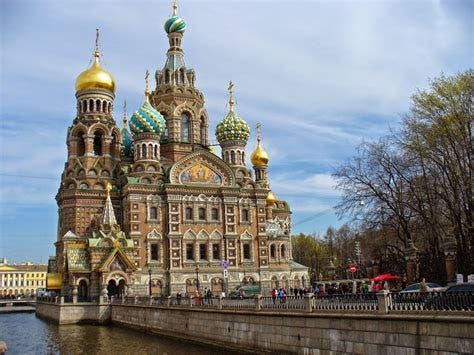In a previous post, the practice of serfdom was discussed. It was similar to slavery, except that slaves are the human property of their owner, whereas serfs belonged to the land, although they were also sold as property by unscrupulous landowners. This practice was abolished in Russia in the year 1861 by Tsar Alexander II, known as the Liberator.
Tsar Alexander was responding to calls for reform in the Russian empire. People had been watching western Europe as it moved towards democracy and self-determination, but Russia remained autocratic. Despite the Tsar’s efforts to reform the state, some of the more radical elements of Russian society remained dissatisfied, and he was assassinated in 1881.
A church was erected in St Petersburg on the spot where Tsar Alexander II was killed. It is called the Church of the Savior on the Spilled Blood (below). To this day, it remains unconsecrated, because the church is not a parish where the faithful celebrate Divine Liturgy. Rather, it serves as a memorial to the fallen reformer, and as a museum for Russian art and architecture.
Successive tsars in the late-19th and early-20th centuries continued to answer calls to reform the Russian state, but were unable to avoid a revolution in 1917, followed by a civil war. During the reform period, however, prior to the revolution, the tsars sought to loosen the state’s control over the Church.
In imperial Russia, the Church and the state were tightly bound together. In the early 1700s, the Patriarch of Moscow died and Tsar Peter the Great allowed the office to remain vacant. In the place of the Patriarch, Peter created the holy synod, which was a government office for oversight of ecclesiastical matters. Among the roles of the synod was to censor any books that might be published in the Russian language.
Censorship was gradually loosened in the decades leading up to the revolution. The result was a flowering of religious thought that is known as the Silver Age. Theologians gained the freedom to publicly discuss some of the unexplored areas of Orthodox Christian doctrine.
One topic is a term translated literally as ‘Godmanhood’. It comes from the Russian term Bogochelovechestvo (from Bog, which is 'God,' and chelovek, 'human being'). The concept is a little complex, and Bogochelovechestvo may be better translated as ‘Divine Humanity’.
We know that God is complete and total, and nothing can be added or removed from Him. So, before creation, in the mind of God, He already had a thought for humanity. He also already knew that His Son, Jesus Christ, is both God and man. The Greek term for Christ as the Godman is Theanthropos.
Humanity, therefore, has always existed as a thought in God’s mind, and it has always been inseparable from Jesus Christ. The logos for humanity (the truth of a thing as it exists in God’s mind) is not just humanity, but divine humanity. And the Russian term for this is Bogochelovechestvo.
Divine humanity became a Person in Jesus Christ, the Second Person of the Holy Trinity. Yet, all of humanity participates in this divine energy, because Christ has humanized divinity and divinized humanity. We are made in the image and likeness of God. While each person, individually, strives to become closer to God, history itself takes on a new meaning, because humanity is God’s partner and a divine agent to build His kingdom on earth.
Since God is complete and total, and His essence is unchanging, how is it possible that He created the world? God must be able to move beyond Himself through His work, or else His own absolute essence would confine Him like a cage. For the greatness of God’s love, He was moved to act and create the world. In this way, God’s essence is transcendent and cannot be known by people. But His work and energy is immanent, and people can participate in it.
This was a topic of debate in the 14th century, when a Greek archbishop, St Gregory Palamas, argued in favor of hesychasm, or humanity’s ability to participate in God’s energy. While the concept of divine humanity was not directly discussed at this time, the debate was a precursor that led to the development of Bogochelovechestvo in the Russian tradition. Those arguing against St Gregory felt that a direct experience of God is impossible, taking instead a more rational and scholastic approach.
The Orthodox Church has deemed this concept to be of such profound significance that the second Sunday of Lent is dedicated to St Gregory Palamas. It reminds us that the goal of prayer is to seek God. Specifically, we seek a vision of God known in Greek as Theosis. St Gregory’s favorite example of theosis is the Transfiguration of Jesus Christ, when three of Christ’s disciples saw Him turn into blinding white light.
Bogochelovechestvo is the idea that we are already divine, and we constantly seek to realize our divinity through prayer and the practice of our faith. The human person has already been made divine by Jesus Christ, whether or not someone is a believer. The only question is if we want to pursue this realization, by knowing God and having a vision of Him.
After the Russian revolution, the faithful in Russia were persecuted. Those who were able to flee left the country, but the borders were soon closed. Some of those refugees brought the ideas of the Russian Silver Age to the Western world. The idea of Bogochelovechestvo became a little controversial because, when followed to its logical conclusion, various theologians and hierarchs did not like the implications.





